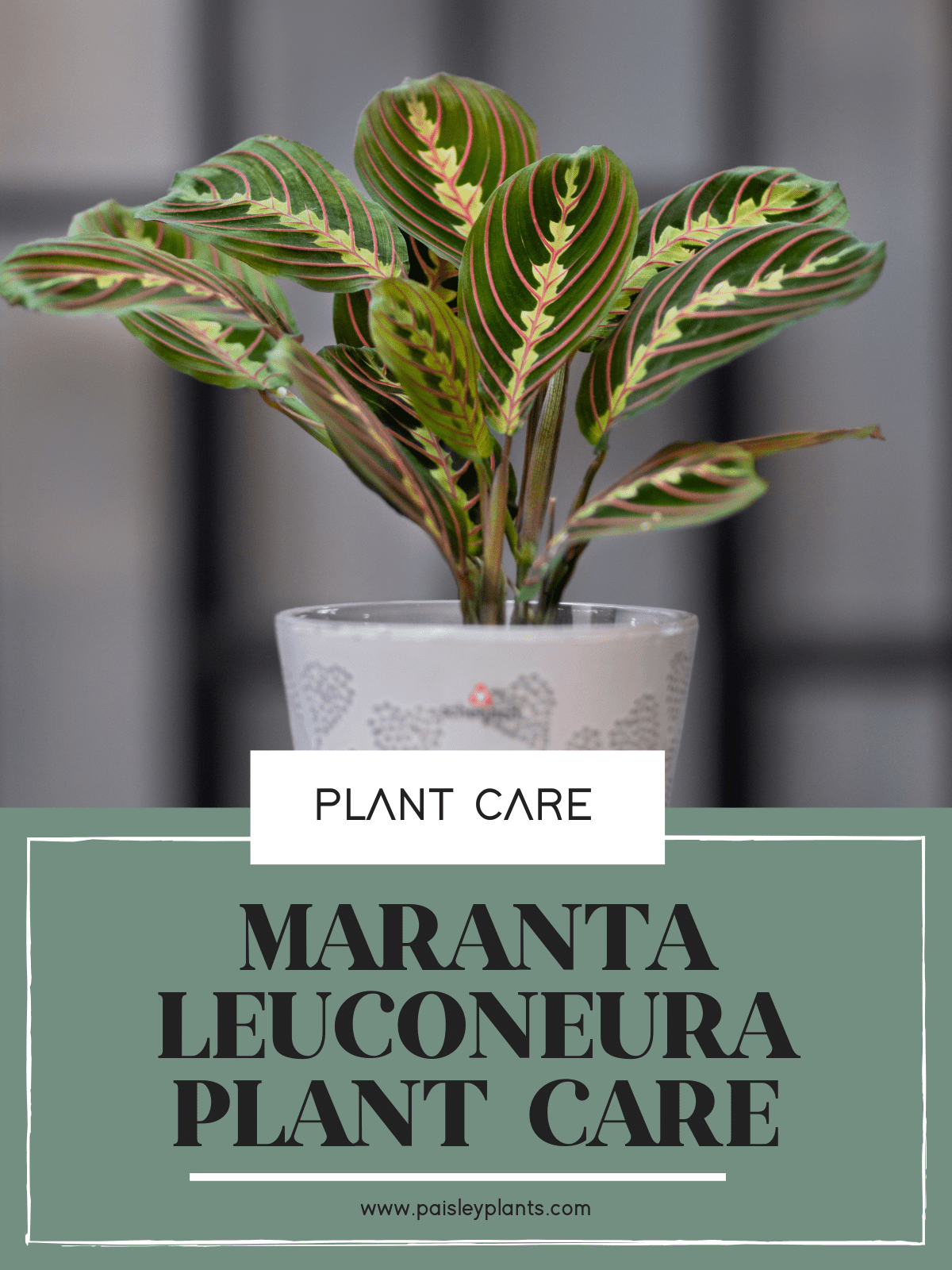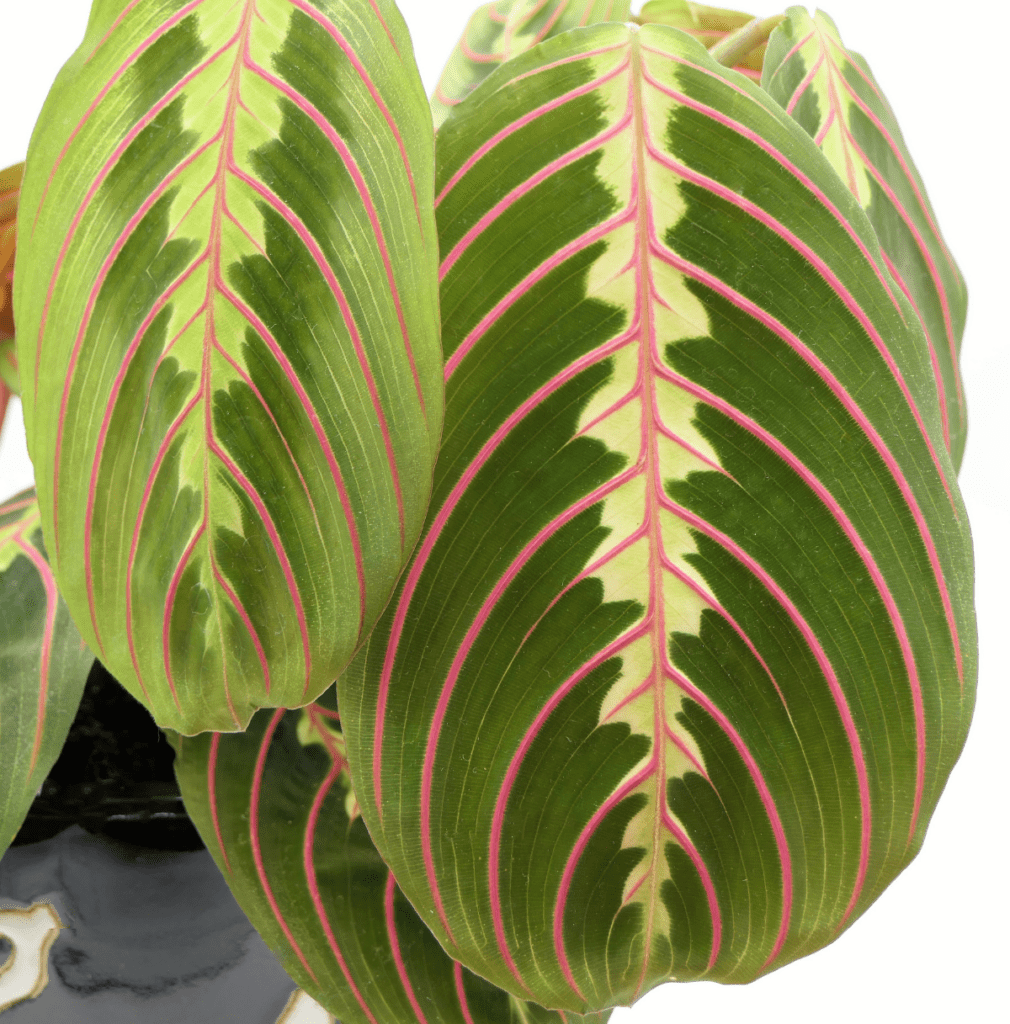Bold, beautiful, and tropical: the Maranta leuconeura is a must-have houseplant. But just because it is immensely beautiful, doesn’t mean that it is difficult to care for!
In fact, you’ll be pleasantly surprised by how easy and straightforward it is to care for the Maranta. Read on for this ultimate prayer plant care guide.

Table of Contents
Background
The Maranta, otherwise commonly known as the prayer plant, is a tropical low-growing plant. The prayer plant is originally native to South America, though today, these plants have been globalized into becoming one of the most recognizable houseplants.
Besides the prayer plant, other common names include herringbone plants, rabbit tracks, and cathedral windows plants.
These plants are revered for its beautiful leaf pattern. The oval shaped leaves are predominantly green, but with a distinct pink vein pattern on the leaves.
These plants are considered to be medium-sized plants. At full maturity the maranta will only reach to a height and spread of 12 inches.
These plants are non-toxic to both pets and humans. You can safely own a prayer plant without worrying about toxicity.
Maranta leuconeura Prayer Plant Care

It’s fairly easy to care for and grow prayer plants. Here’s some tips to help your plants thrive!
Sun & Light
Your maranta should be given a full day’s worth of bright, indirect light. Please avoid placing your plants in a location with direct sun. Direct sun exposure can cause leaf damage to your plants, ruining the beautiful foliage.
Soil Type
Prayer plants grow in many potting mix types, as long as they are well-draining. Your plants can comfortably live its life in a generic store-bought potting mix.
However, for gardeners who would rather mix their own potting mix, you can use a mixture of two parts peat moss, one part loam soil, and one part perlite. In addition, the ideal pH range for these plants is 5.5 to 6.0, which falls under acidic.
Water
The prayer plant prefers to be consistently moist, and does not fare well under drought like conditions. You should water your plants frequently (more water is usually required during the summertime), but exercise caution as not to over-saturate your plants with water.
A good rule of thumb when it comes to watering these plants is to wait until the top 1 to 2 inches of soil has dried up before watering.
Fertilizer
Your maranta should be fertilized throughout the entire year, though with varying frequencies. Fertilize your plant every two weeks during the spring through the fall.
During the wintertime, reduce this to only once every month. Select a houseplant-specific fertilizer that is water soluble and dilute it to half its strength.
Temperature & Humidity

Prayer plants are very tolerable of normal household temperatures. Aim for a temperature range of between 60° and 80° F, which is very attainable for most households. Avoid any air temperatures that are lower than 60°, as this can cause the leaves to fall.
Prayer plants benefit from increased air humidity. Many gardeners prefer to place their an air humidifier to keep them extra comfortable in indoor conditions.
Pruning & Maintenance
Prayer plants are fairly slow growers, and do not require frequent pruning. However, if you do spot any dead or damaged foliage on your marantas, you should be quick to prune them. By pruning any defective foliage, you’re allowing your maranta to make way for new, healthy growth. Always remember to use clean, sterile pruning shears when trimming your plants.
Choosing a Container & Repotting
The most important part of choosing a container to house your Maranta is drainage. Your plant pot should have a few drainage holes drilled into the bottom of the pot. A pot with good drainage will help prevent water-based fungal diseases, such as root rot.
Because this plant is such a slow grower, it will not need to be repotted frequently. I would recommend repotting your prayer plant once every two years. When repotting your plant, size up the pot very gradually, about 1 to 2 inches larger than the previous.
Propagating Prayer Plants
The easiest and most common way for propagating prayer plants is through a stem clipping and water propagation. This is how I typically do all of my propagating of my plants when possible.
Here how to do it:
- Find a stem on the main plant that has a few leaves and at least one node on it. A node is a small bump on the side of the stem.
- Cut the stem below the node.
- Fill a jar or propagation station with water.
- Remove any leaves that will fall below the water line when you put the plant in.
- Put the stem clipping in the water ensuring that the node is fully covered.
- Wait a few weeks and watch for roots to appear!
- Once roots get a few inches long, you can now plant your new plant in a pot.
This is the easiest way to get new plants to share with friends!
If you want another way, you can also propagate through division. By doing this you cut the mother plant into smaller divisions. Keep in mind that dividing the plant causes it to become significantly smaller, so this is recommended once the plant has become mature and large enough to be cut into pieces.
Follow these easy steps to propagate your Maranta via division:
- Gently remove your mother plant from its container and loosen up the root ball, shaking out the excess potting mix.
- Use a sharp, sterilized knife and cut the root ball into separate divisions. Each section of the plant should have a decent amount of roots in order to sustain life.
- Prepare a few small, shallow pots with pre-moistened potting mix.
- Place the plant divisions and put them into their own pot.
- Place these new plants in a location with bright, indirect light and warm, humid air. Keep the soil consistently moist for the first 3 to 4 weeks or until you begin to notice new growth forming.
Common Pests
The Maranta leuconeura var is susceptible to a few very common household pests, including mealybugs and spider mites. While these pests can pose an incredible nuisance to you, there are easy and natural approaches to dealing with them.
The most common approach utilizes neem oil, which is a natural horticultural oil and a pest repellent. If you notice a pest infestation, spray your plants with neem oil and remember to trim and dispose of any damaged foliage.
Common Diseases
Many plants that prefer moist, humid locations can run the risk of being exposed to root rot, which can be a deadly and troublesome disease. Excess moisture can become trapped in the potting mix, which eventually harbors bacteria and breaks down the roots. Root rot can be treated if plant owners act quickly. Telltale signs of root rot include wilting, yellowing foliage.
Follow these steps to help combat root rot:
- Remove your plant from its pot and gently shake away excess dirt.
- Inspect the roots; rotted roots are mushy and black compared to the firm, off-white color of healthy roots.
- Take a sterile pair of scissors and cut off any rotted roots you see.
- Repot your plant using clean, new soil in a pot that has drainage holes
FAQ
Fading leaves or splotchy leaves sounds like a light problem. When prayer plants are exposed to direct sunlight, it can cause the leaves to suffer heavily. Always make sure that you are providing bright, indirect light to your plants to avoid any damage to the leaves.
Yellow leaves and wilting leaves are very common symptoms that your plant is being over watered. When a plant is getting too much water, it can be extremely hard for the soil to naturally expel the excess that it does not need.
Over time, standing water can develop bacteria, which causes root rot. If you suspect this to be the case, please check out our great section on how to remedy root rot.
In the future, always make sure that you are allowing the top couple inches of soil to dry before you water your plant. In addition, your plant should be growing in a well-draining potting mix in a pot that has ample drainage holes.
Dropping leaves are a common occurrence when a prayer plant is exposed to low temperatures. Please remember that the ideal temperature range for growing these plants are within 60° to 80° F. Avoid placing your plants near cold areas such as near air conditioning vents or drafty windows.
If your plants have brown or falling leaves, this could be a sign of too much fertilizer. When the fertilizer is too strong, it can be counterproductive and burn the roots of the plant. When the roots of the plant burn, it causes the leaves to turn brown.
Properly fertilizing your plant is the easiest way to avoid this altogether. Remember to dilute your fertilizer mixture to half its strength. Fertilizer should only be used every two weeks during the spring, summer, and fall. Lighten up your fertilizer routine during the wintertime, reducing only to once a month.
I hope these care tips and tricks help you successfully grow and care for a Maranta Leconeura with success in your own home garden! It doesn’t take much effort to care for and grow beautiful Maranta plants!
Despite its beauty and rarity, it is in fact one of the easiest houseplants to grow and care for. With a prayer plant, you can bring a piece of the South American tropics into the comfort of your home!
Be sure to check out the lemon lime prayer plant here!

